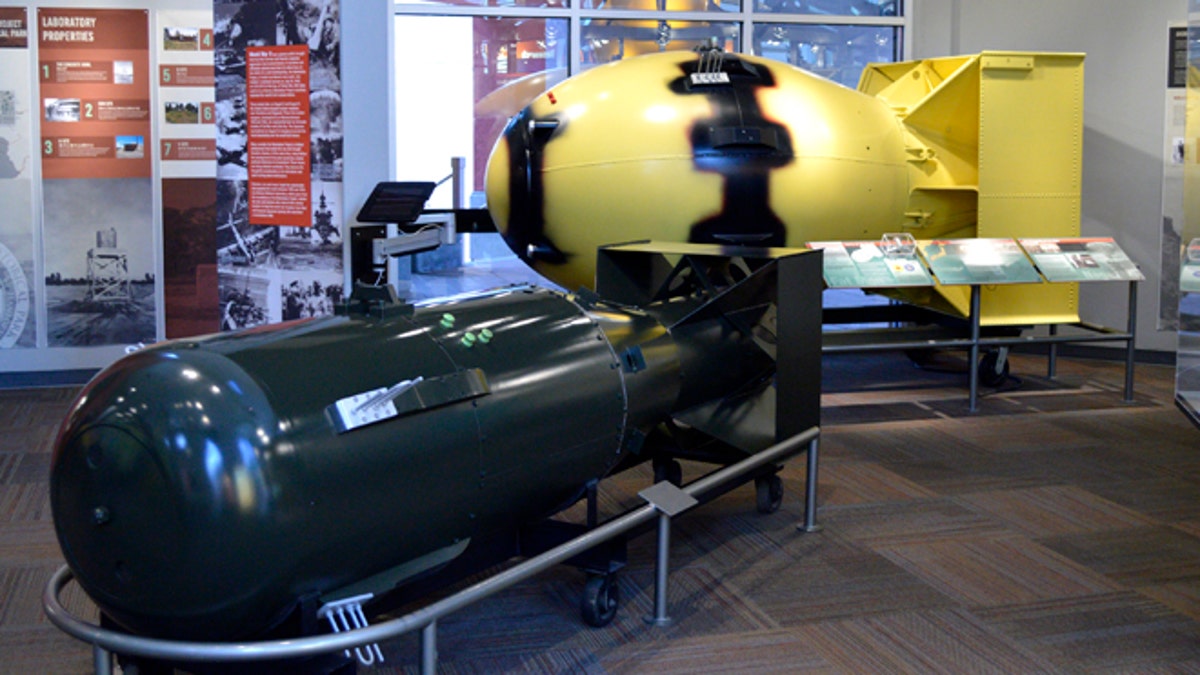
This July 13, 2015 photo shows replicas of atomic bombs "Little Boy," left, and "Fatman," both dropped on Japan during World War II, sit at the Bradbury Science Museum in Los Alamos, N.M. Thursday, July 16, marks the 70th anniversary of the Trinity Test in southern New Mexico and comes amid renewed interest in the Manhattan Project thanks to new books, video oral histories and a WGN America television drama series. (AP Photo/Russell Contreras)
In light of President Barack Obama’s historic upcoming visit to Hiroshima, Japan, citizens in Tularosa, New Mexico, are hoping he will visit their town as well.
They say generations of residents, predominantly Hispanic, have suffered from cancer and related health issues resulting from the Trinity Test – the name of the first atomic bomb test, which occurred on July 16, 1945, some 35 miles from the old Spanish settlement of 3,000 people.
Obama will be the first sitting American president to visit Hiroshima, the city known as the site where 140,000 people were killed when the U.S. dropped an atomic bomb on Aug. 6. Nagasaki was bombed three days later, and 75,000 people died. Less than a week after the bombings, Japan surrendered.
Scientists working in a secret compound in Los Alamos, New Mexico, developed the atomic bomb as part of the Manhattan Project.
Following the Trinity Test, residents of the mostly Hispanic and Native American towns downwind of the site allege, a wave of cancers and other illnesses began to sweep through the areas of southern New Mexico.
Over the decades, locals have demanded that the government acknowledge the connection between the radiation exposure and health problems. Tularosa "downwinders" have been largely ignored for the last 70 years.
The mayor of Tularosa, Ray Cordova, is a lifelong resident of the town. He told Fox News Latino that his father died of stomach cancer.
“We feel the bomb is responsible for a lot of the cancer here. Not a family in this community hasn’t lost someone to cancer,” he said.
The National Cancer Institute, at the behest of the Centers for Disease Control and Prevention, surveyed residents who were believed to have been exposed to radiation from the Trinity fallout and food and water that was contaminated by the blast.
According to historical records at Los Alamos National Laboratory, Southern New Mexicans were never warned about the Trinity detonation or advised to take safety or dietary precautions either before or after the blast. The Los Alamos Historical Document and Retrieval Assessment Project also concluded that radiation levels in some public areas were 10,000 times what was considered safe exposure.
“No one who lived downwind of Nevada Test Site has had to prove the damage to the government like we have. People in Nevada received more than $2 billion in compensation. What’s more important, they received healthcare coverage. People here have no access to cancer treatment, you have to travel for treatment. It’s very rural,” Tina Cordova, co-founder of the Tularosa Basin Downwinders Consortium and the mayor's niece, told Fox News Latino.
New Mexico's Sen. Tom Udall, a Democrat, said in a statement that residents of Tularosa deserve recognition from the U.S. government and coverage under the Radiation Exposure Compensation Act (RECA). The program provides a payout of $50,000 to residents who lived downwind of the Nevada Test Site as compensation for health problems.
"The legacy of Hiroshima and Nagasaki – and the tragic human impact of nuclear weapons testing in Tularosa, New Mexico, and elsewhere in the world – is still being felt today. These experiences show us why we must continue to prevent the proliferation of nuclear weapons and ban nuclear testing, so that civilians never again become victims of a nuclear blast,” Udall said.
Mayor Cordova told FNL, “My feeling is this, that thing [the Trinity test] contaminated the Tularosa valley. The cloud moved across the sky, and the soil and the water got contaminated.”
“We need help," he added. "People can’t afford the medical bills. And they should research to see what’s causing this. I’m a lifelong resident of Tularosa. It seems like we were used as guinea pigs here.”
On July 16, the town will hold an annual candlelight vigil for those who died from cancer. The names of loved ones will be read aloud, and a gong will be struck. Last year more than 500 names were read.
“This year we’re going to invite Pres. Obama to come," Tina Cordova said. "We want him to know that we support his trip to Japan, but we’d like him to come and acknowledge where it all started and the sacrifices we made. It’s a moral and ethical issue for the U.S. to take care of its citizens. We were overexposed.”
She said her organization has two pressing issues. One is for the RECA amendments to be passed to financially cover people of southern New Mexico. The second is an apology for what’s occurred.
“They never did another test like this again," Cordova said. "They knew they need to be 150-mile radius from people, and almost 40,000 residents were living in a 50-mile radius of the Trinity site in 1945. It was not remote or uninhabited. It was a plutonium-based bomb with a 24,000 year half-life – that’s long-term radioactive fallout."
She concluded, "We were unwilling participants in this test and that deserves to be acknowledged and compensated.”
